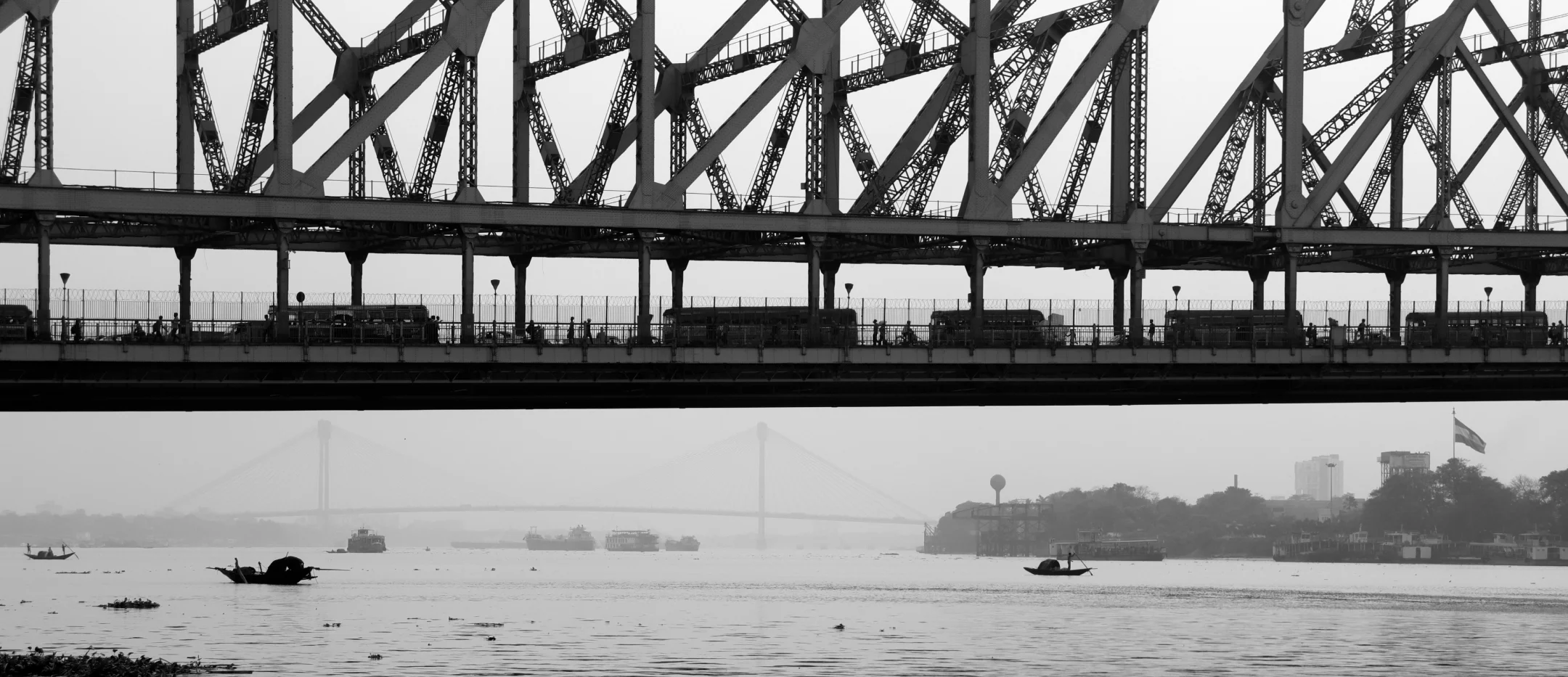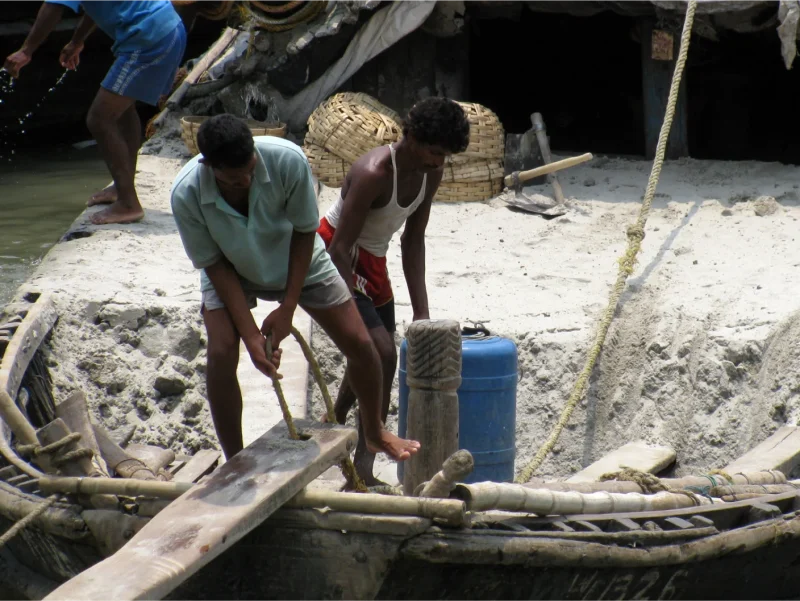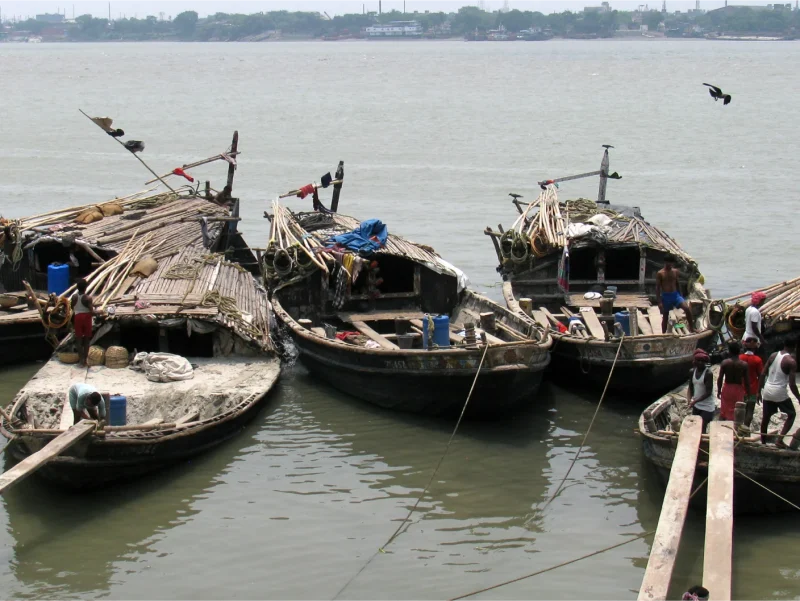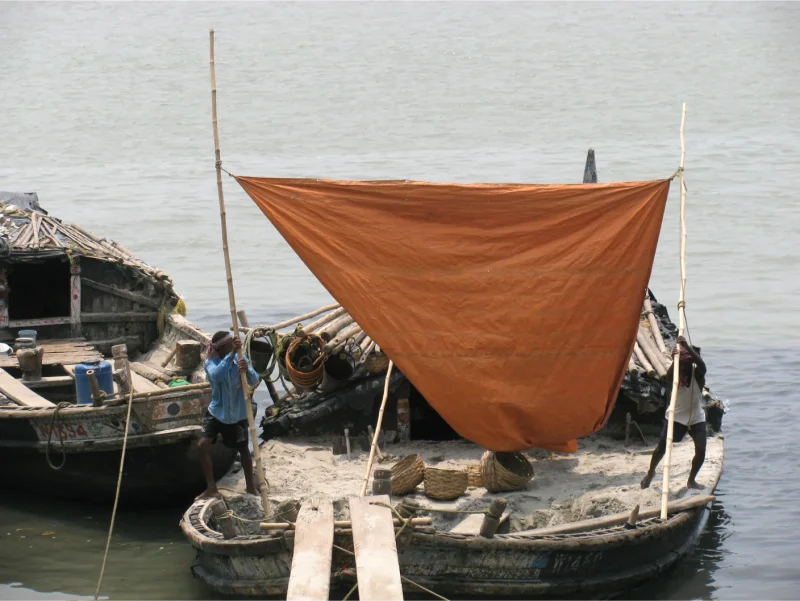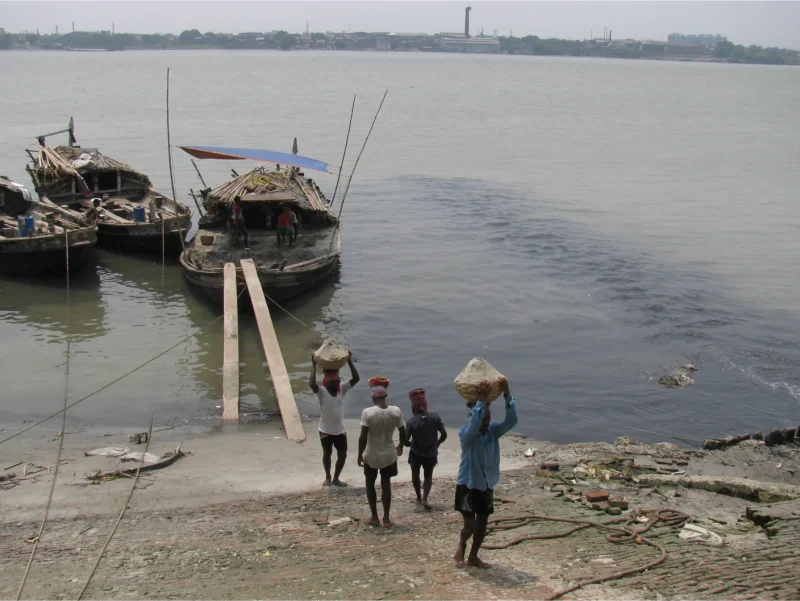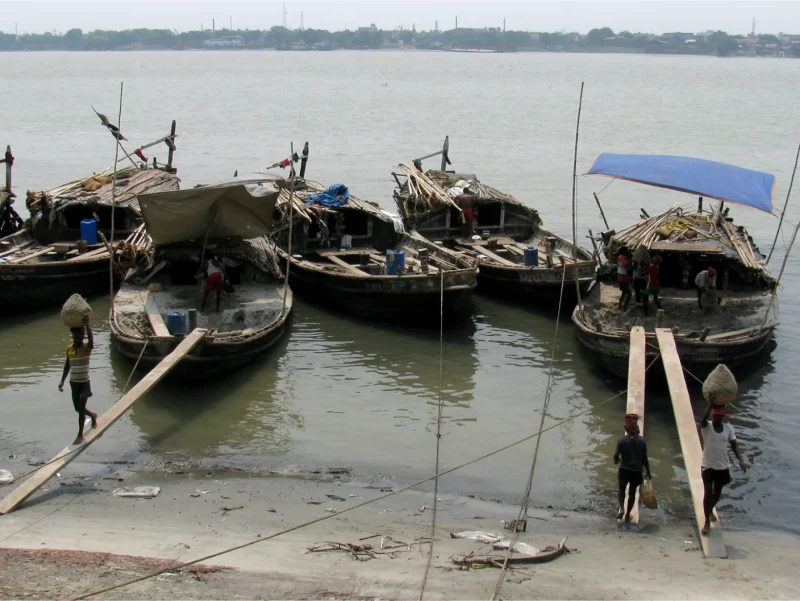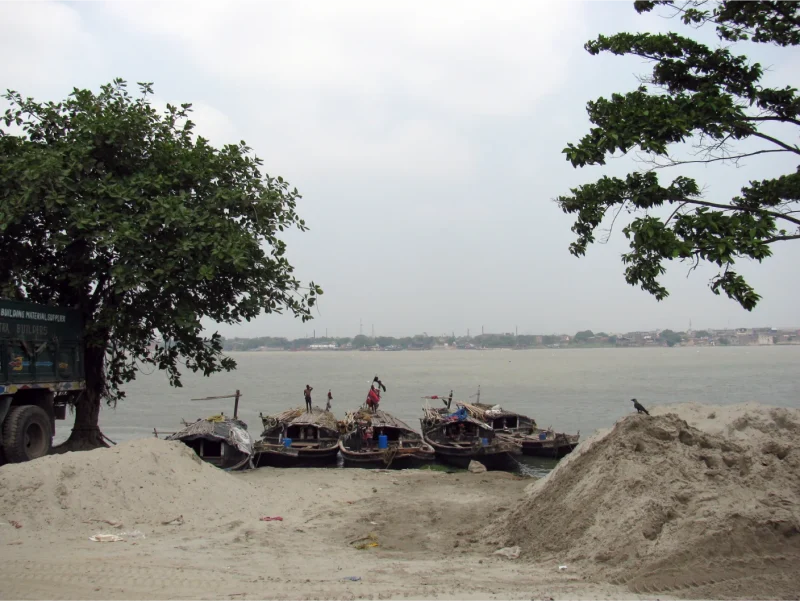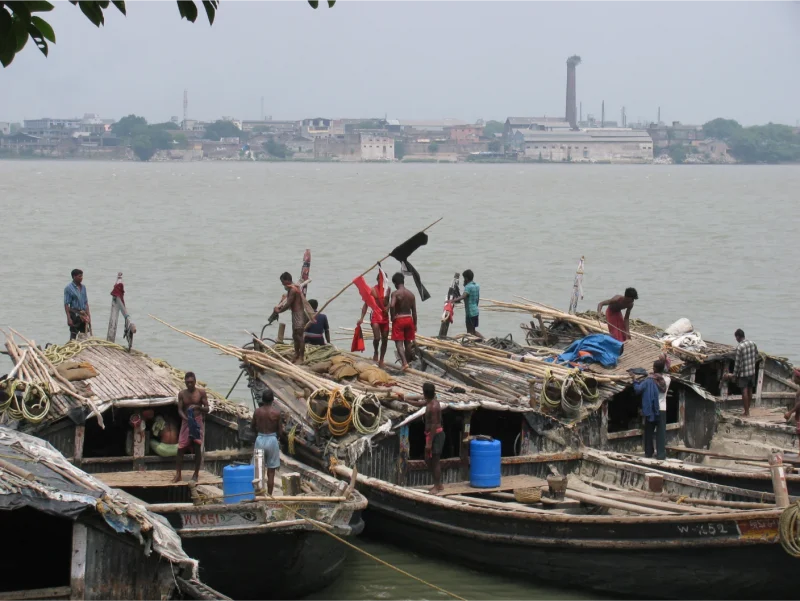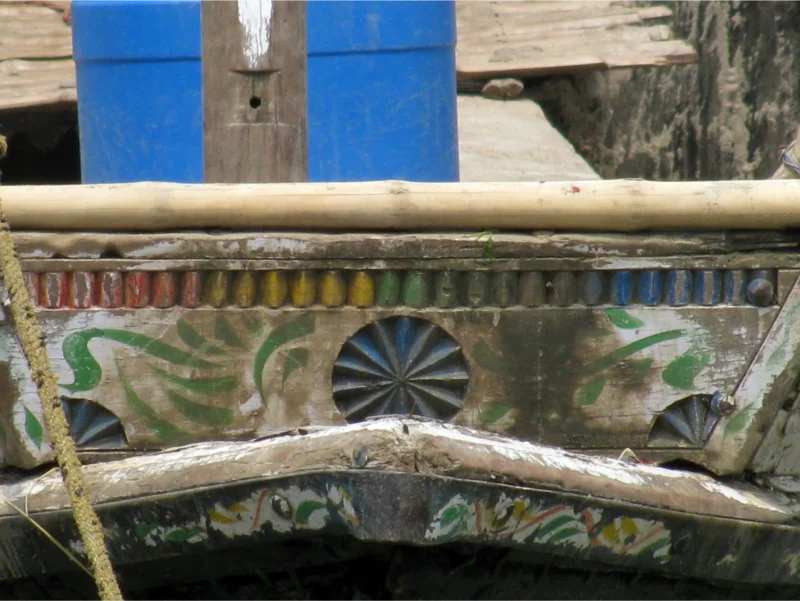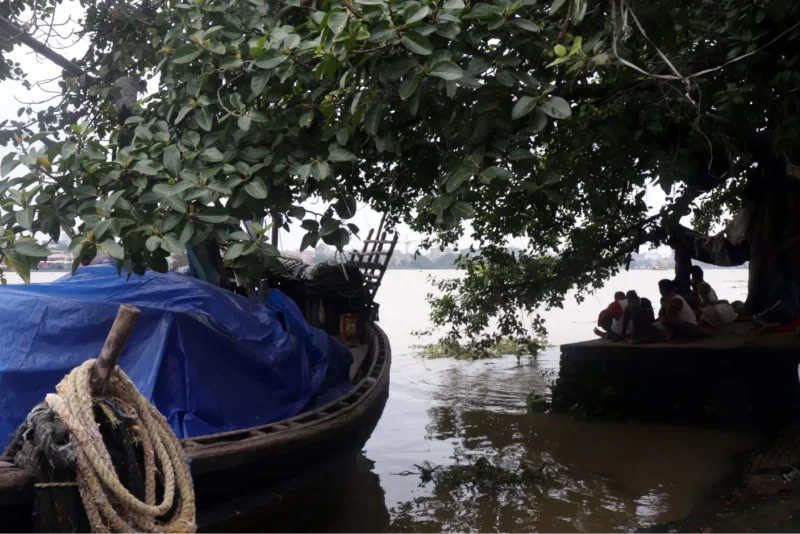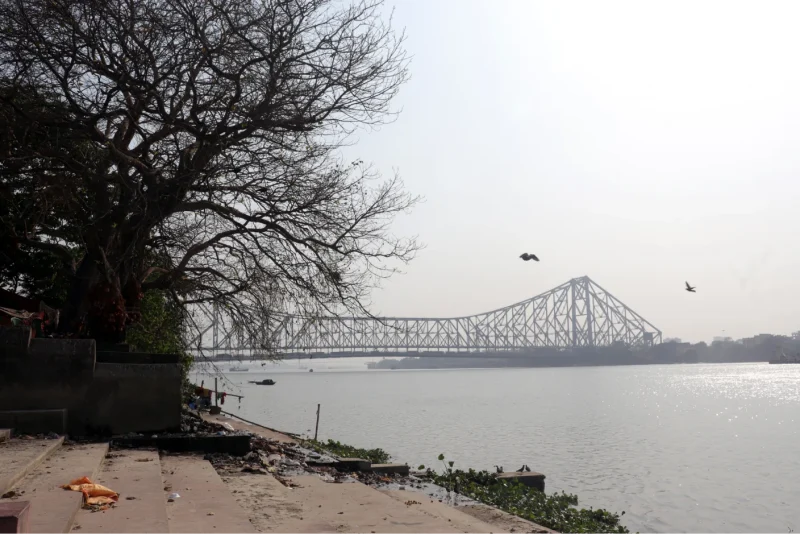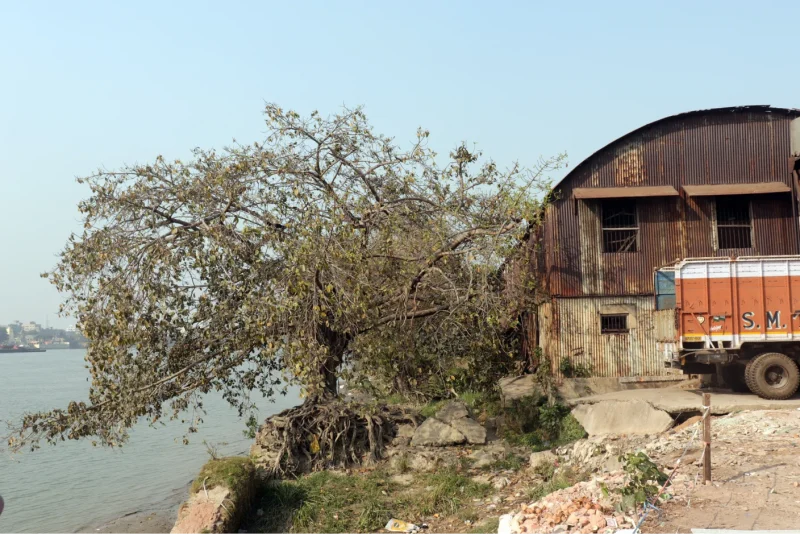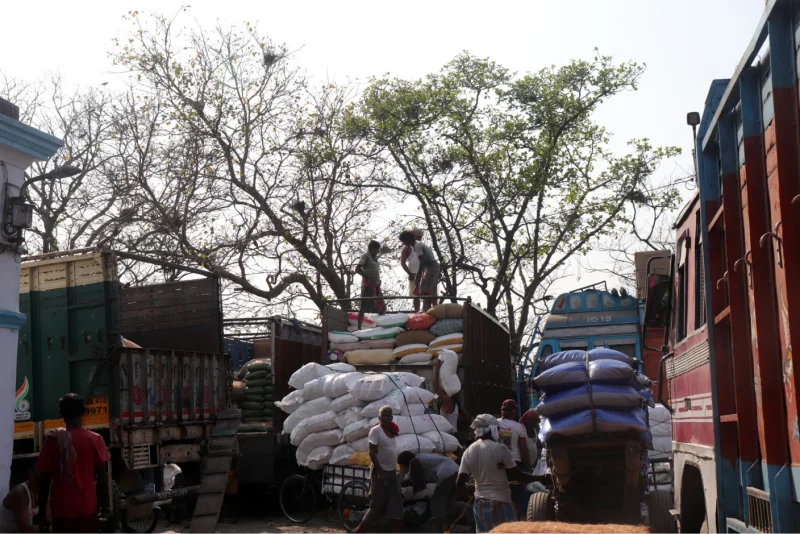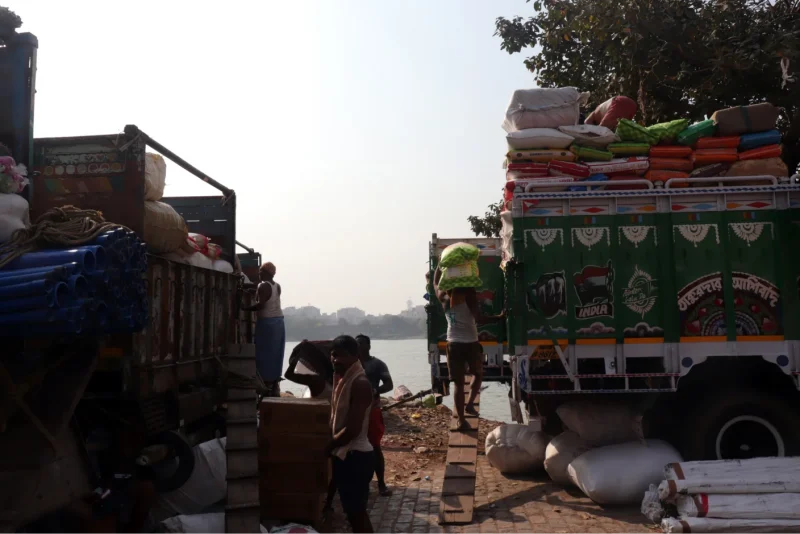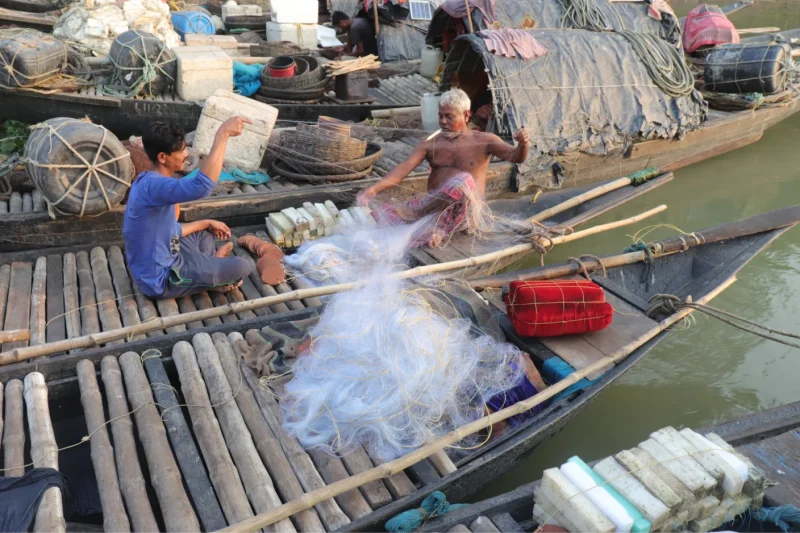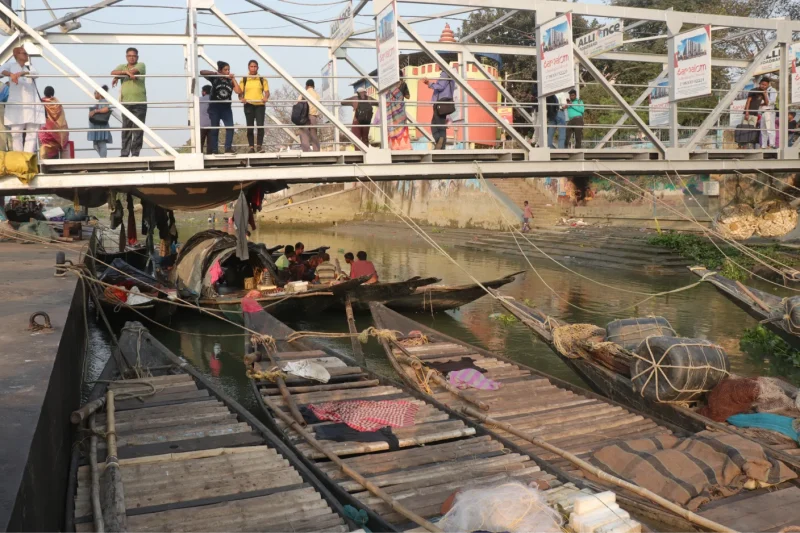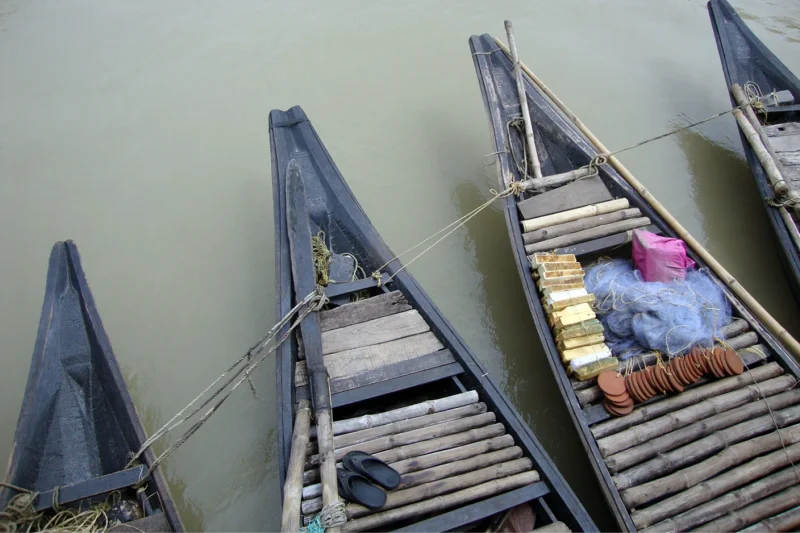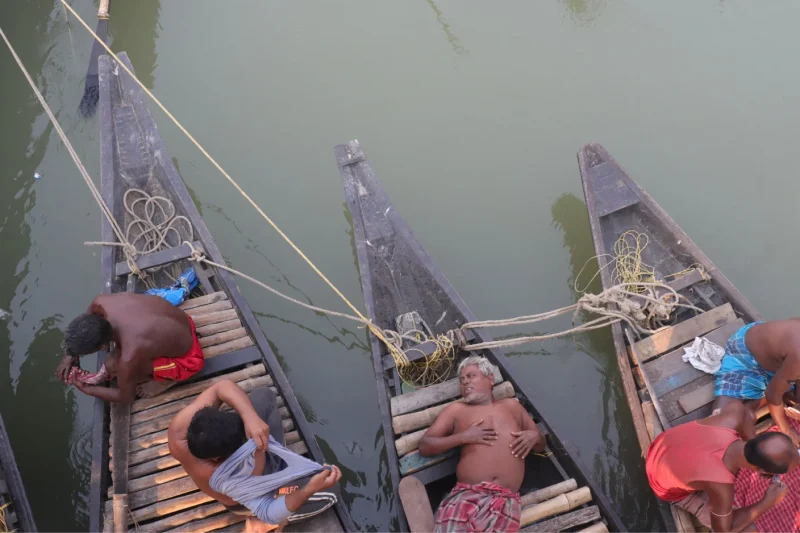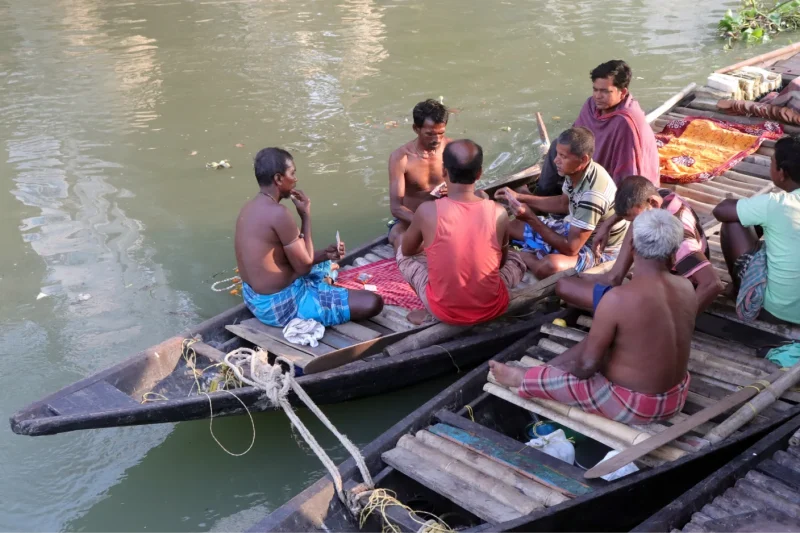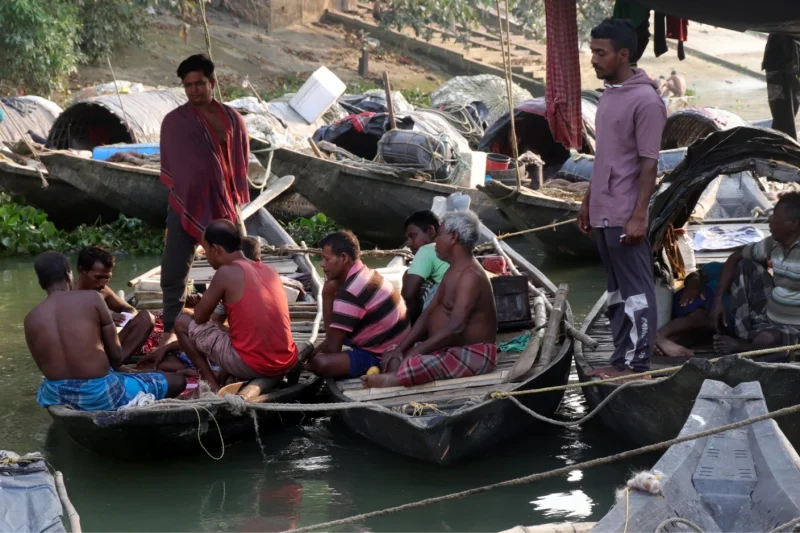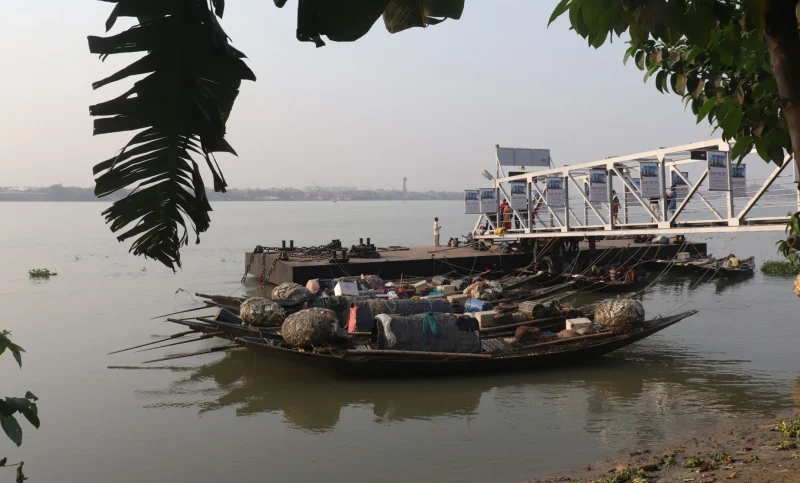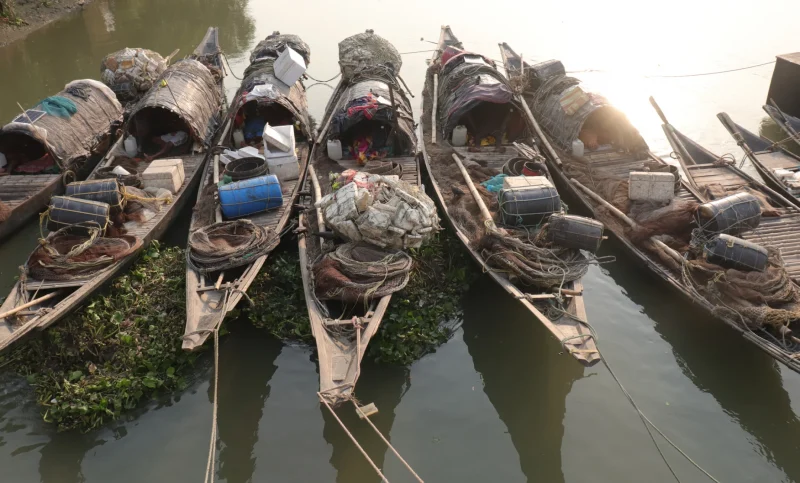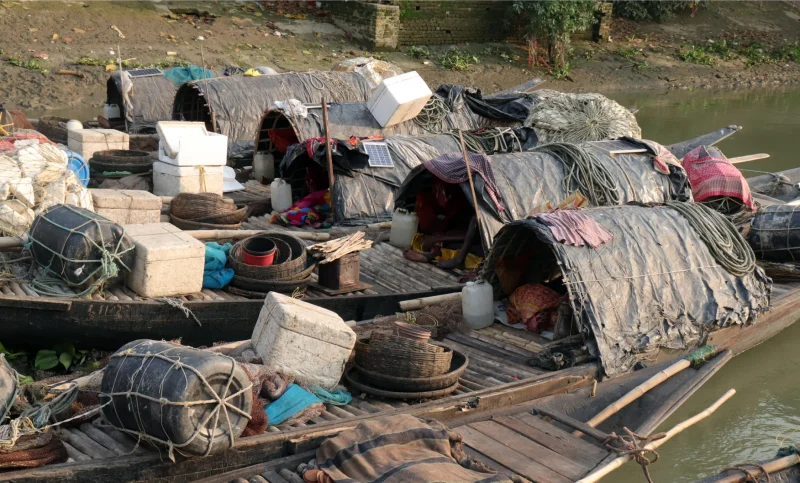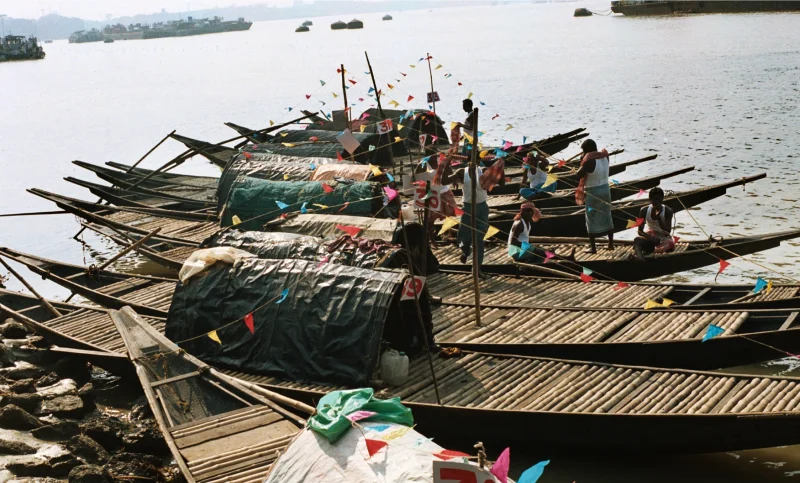The Hooghly River, acted as an ‘aorta’ in the growth of Kolkata. The stretch of river flowing through Kolkata is considered sacred since it is part of the Ganga, and taking a dip in its holy waters is a customary ritual. Historically, this relatively short expanse of river has been a key resource for communication and transport (of goods and passengers) along and across the water. Additionally, as a vital hub of maritime trade, there was an abundance in the variety of boats that made their way into the port city.
With the passage of time, the halo of glory around Kolkata has faded and yet the rudimentary glow persists; even today, there are several varieties of boats that ply on this river with the same typological similarities as those of the past, proving that parts of the old world continue to thrive silently.
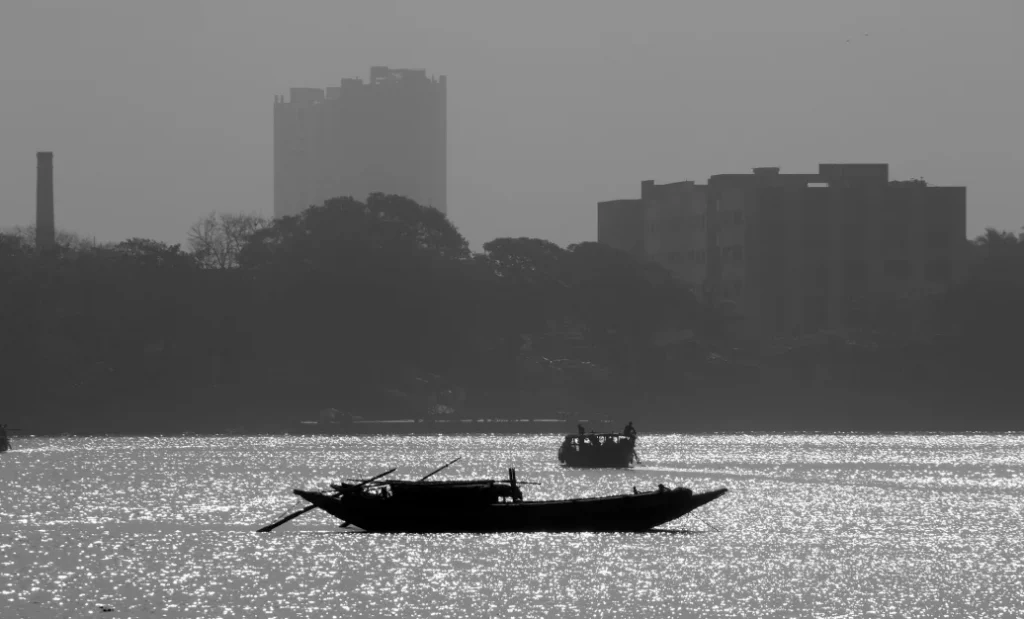
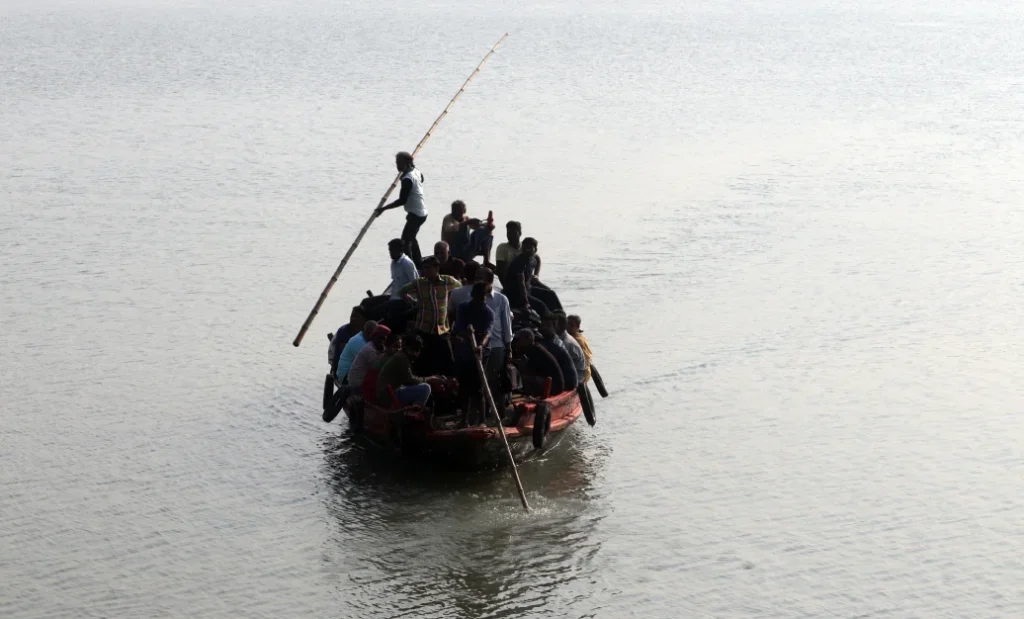
Kolkata – The Vibrant City
Deep-Rooted Influence of Boats
“The old Kolkata has a cultural background since three hundred years as it sprouted on the bank of Hugli river and so here we find the traditional culture even today in an urbanized form. This part of Kolkata has Kumortuli (hamlet of potters), Jele Para (hamlet of fisherfolk), Ahiritola (hamlet of milkmen), and they had a deep connection with water as well as boats. ”
The common boat’s impact can be felt through the various facets of Bengali culture and its symbolic presence can be found in the socio-cultural aspects of both Kolkata and West Bengal. As mentioned earlier, parts of old Kolkata continue to thrive amidst rapid urbanization—the neighborhoods of Kumortuli (the hamlet of potters), Jele Para (the hamlet of fisherfolk), and Ahiritola (the hamlet of milkmen) are all intimately connected to the river and its vessels. That boats changed the course of culture in Kolkata is evident in its various visual representations. From Mohunbagan, the renowned football club, whose symbol is a boat, to the Overhead Reservoir’s Mayurpankhee (peacock feathers) pleasure boat, and finally the significance of the boat in Durga Puja (a popular Hindu autumn festival) where the Goddess uses a boat to journey to Earth, the boat is ever present and ever relevant. A boat was even used as a marketing campaign by a popular shoe company, Bata, to attract new customers. Interestingly, boats are also prominent in the many rituals and customs of the people of Kolkata. During Makar Sankranti (the harvest festival in mid-January), small boats are made with flaps of banana trunks and put on the river Ganga to float which symbolizes the riverine/maritime trade.
Different types of boats represent diverse typologies that relate to their use, the stretch of water on which they ply, and above all the local traditions to which they belong. These typological varieties are Jele Dingi, Jele Bachhari, Pansi, Bhanr, Khorokisti, Sultani, Talai, Mahajoni, etc. (explained later in the story).
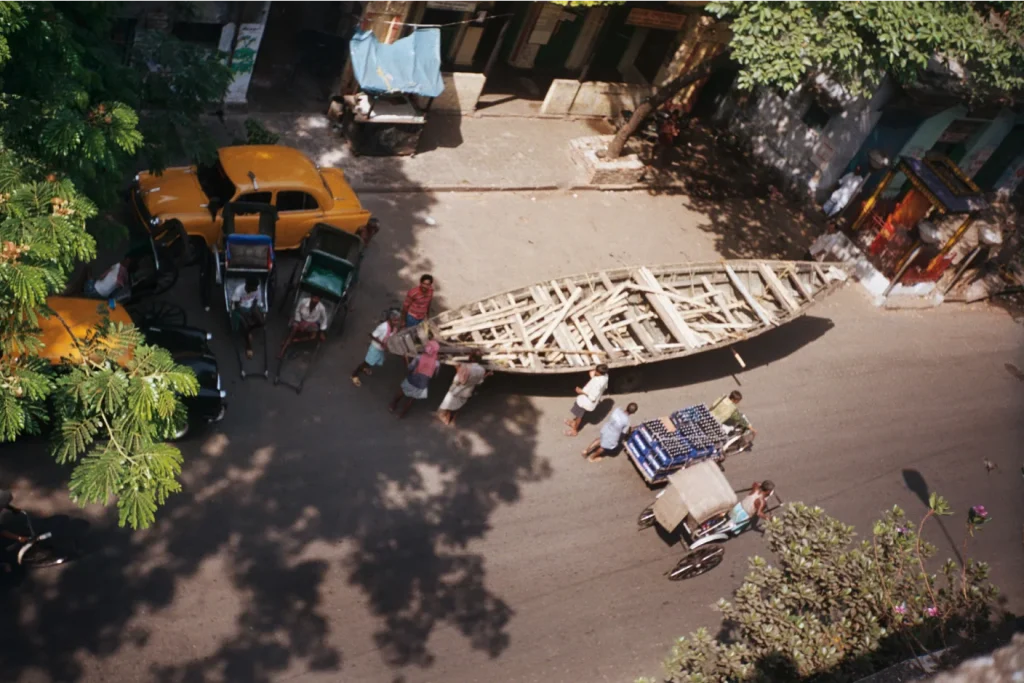
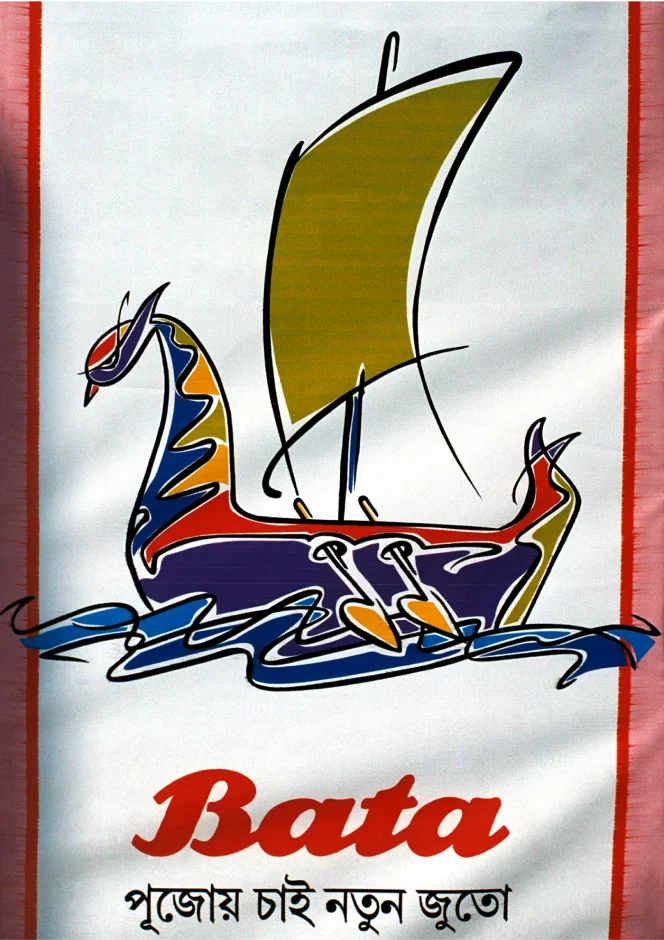
“When boat has penetrated the cultural life of Kolkata’s people is not known exactly but that it has penetrated is for sure as we even today can see use of boats and replicas in various forms representing some major social happenings”
“Mohunbagan, the renowned football club of Kolkata, has chosen boat as their club symbol.”
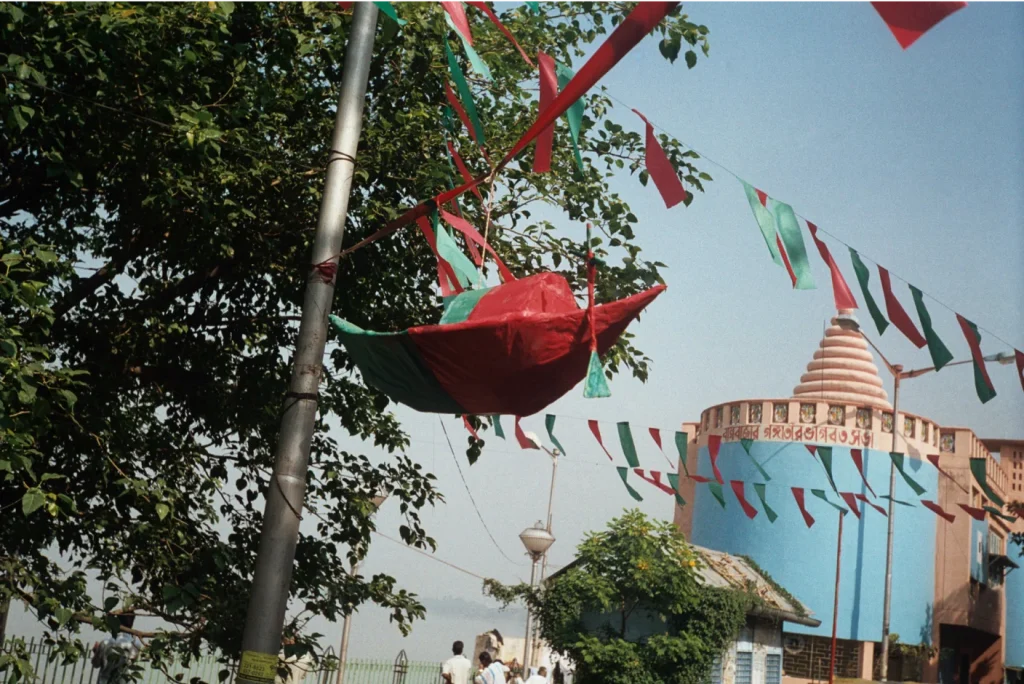
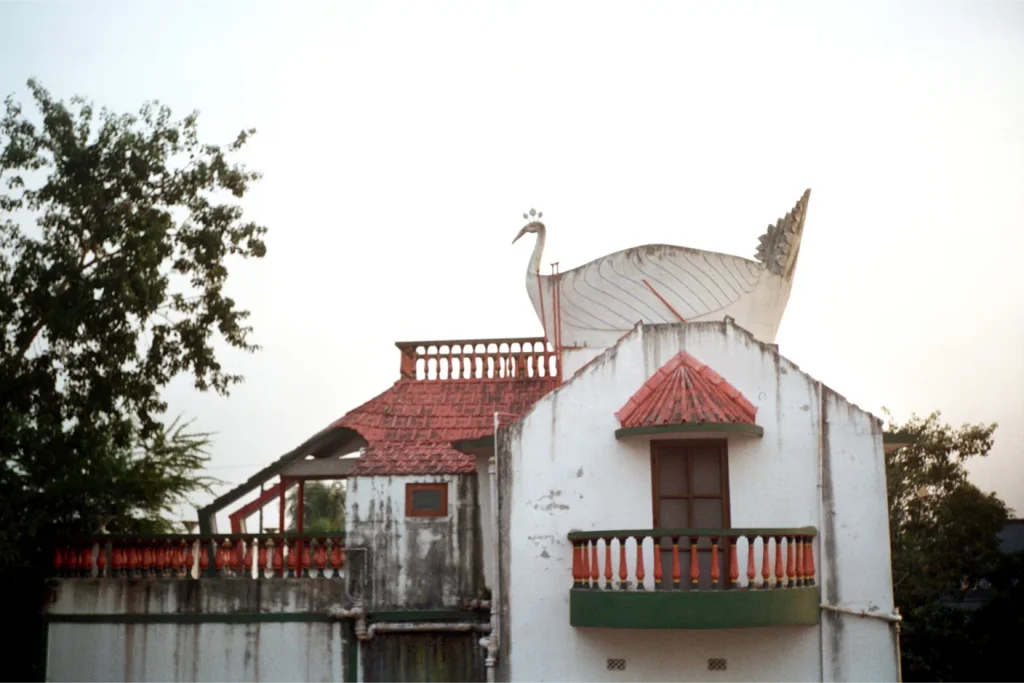
“The overhead reservoir can even take the shape of a peacock headed pleasure boat named Mayurpankhee at Kolkata which gives us an impression that some where boat is embedded deep in their culture. ”
Uniqueness of West Bengal’s Boats
The Common Nouka
The Bengali word nouka is used to include both categories of large and small watercraft. However, a more specific designation would be nouka for a large, rowing craft and dingi, for a small one in which paddling is the more common mode of propulsion. The origin of the West Bengal dingi can be linked with the Austric term dinghy (a shallow boat). In Medinipur, some water vessels such as the Sultani and Khorokisti are called bot (boat). It appears that bot is used to describe big crafts with sails. In Kakdwip, the kakdwip trawler, is always referred to as a trawler, not as a boat.
In West Bengal, boats are built shell first; planking takes place from the central board and then planks are fitted from the garboards (the planks next to the keel) to the sheer strake (the upper edge of the boat’s side). The planks are laid one by one on each side, and joined and fastened with metal staples, called patam or jolui. The hull, therefore, has a smooth surface as opposed to the European clinker-built boats in which planks are laid successively, overlapping one another. After finishing the empty shell of the hull, the ship builders usually add a set of inner frames.
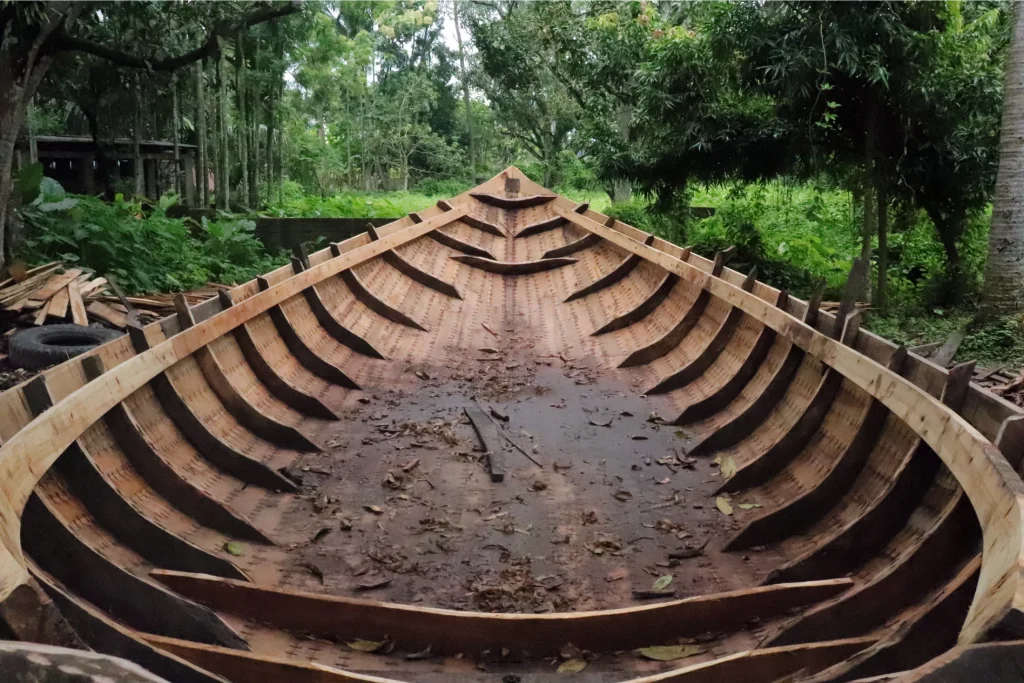
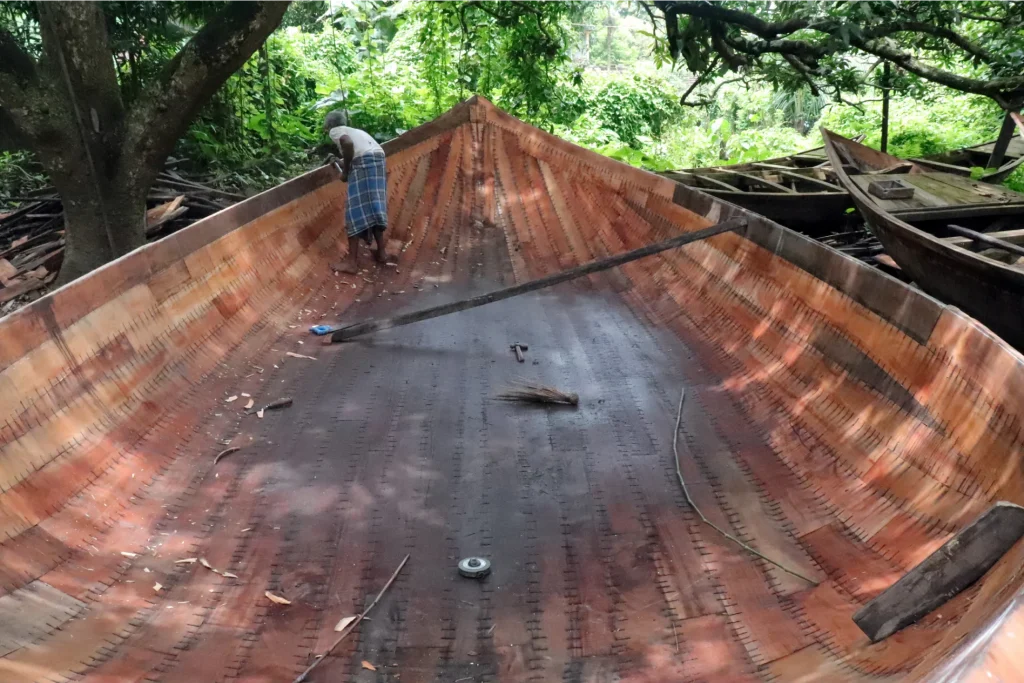
Pansi Boats
These were cargo boats which carried salt from ships anchored at port to the various warehouses located upriver. Over time, the cargo they transported changed and, instead of salt, they now carry white sand (deposited silt) from the char (raised silted riverbed) which is used in road construction and land filling. These boats continue to be operated manually using long oars and the occasional square sails.
Pansis are smooth-skinned, shell built, round hulled boats with long beams and shallow depths. The bottom of the boat is spoon shaped and the craftsmanship is a lot blunter compared to other boat varieties.
“The pansi : ‘pan jaisi’ (beetle leaf shaped) – Near Kashipur, North Kolkata. Round hulled smooth skinned boat with wide beam.”
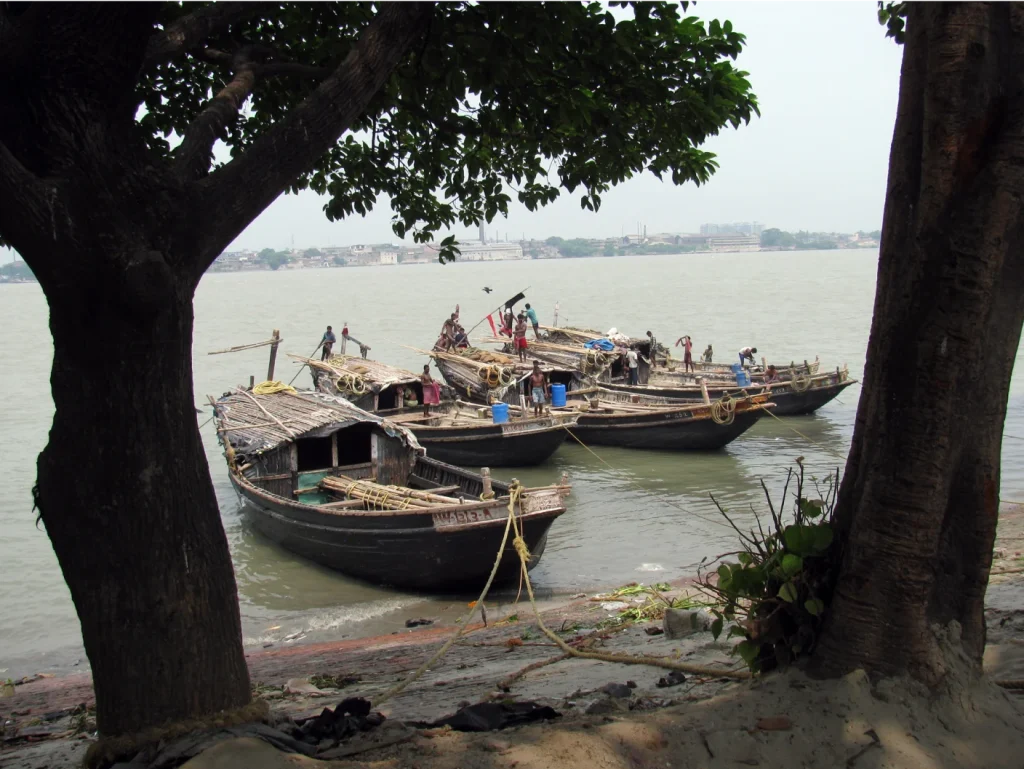
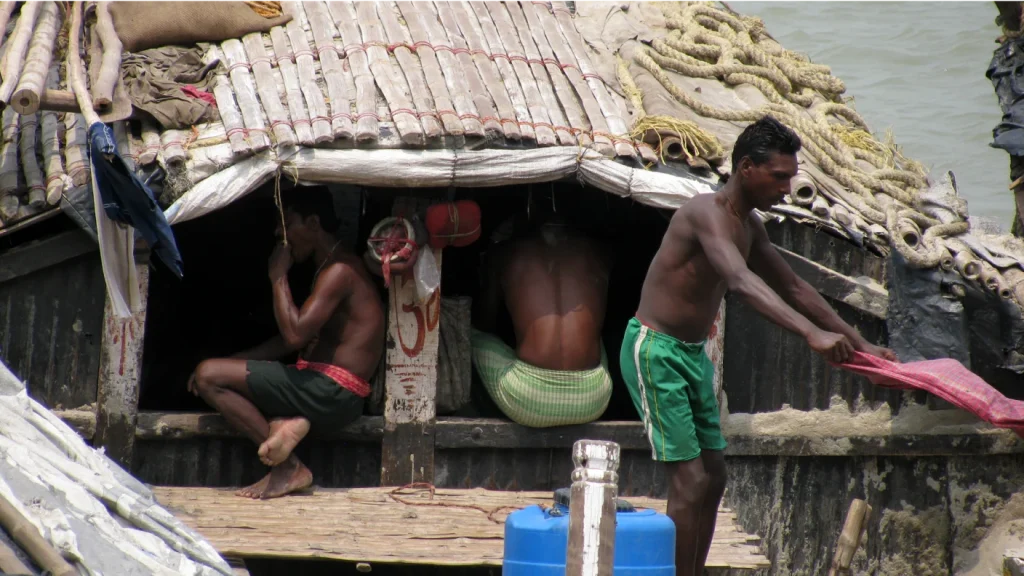
“Release of exertion – Curved permanent shed giving shelter to the boatmen for cooking, eating and resting.”
“Space management – Dredging tolls: an innovative equipment consisting of a bamboo pole, metal sheeted bucket and ropes.”
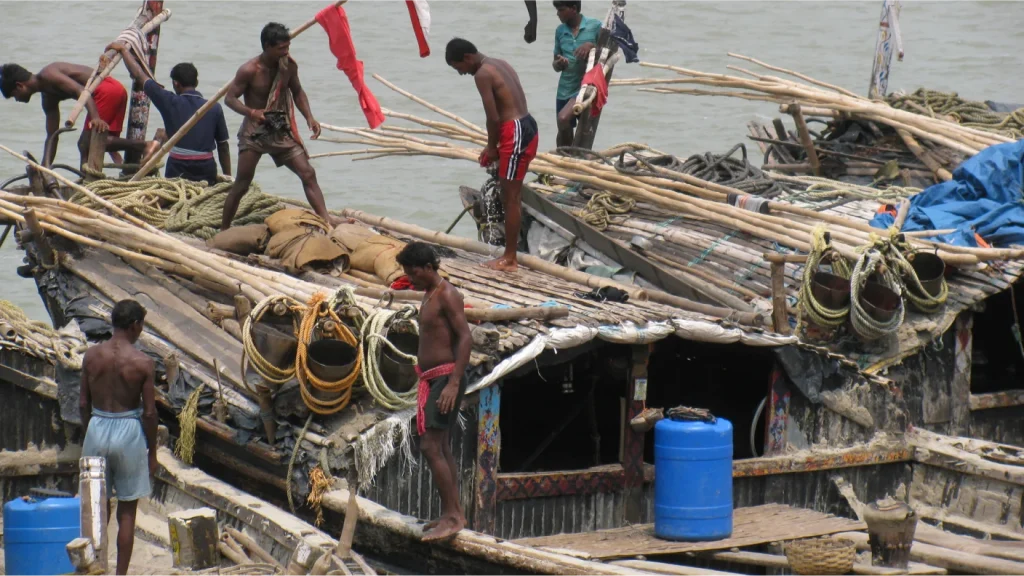
In the 1990s, there were two boat building sheds in full operation at Ghusuri, Howrah district (Ghusuri is situated on the right bank of river Hooghly opposite to Kashipur of Kolkata) which no longer exist. Bijay Babu, one of the owners of the sheds, said that at one-point Ghusuri housed over 250 pansi builders. While the number of boat makers have dwindled, a few are still seen repairing old ones as there is no demand for new boats.
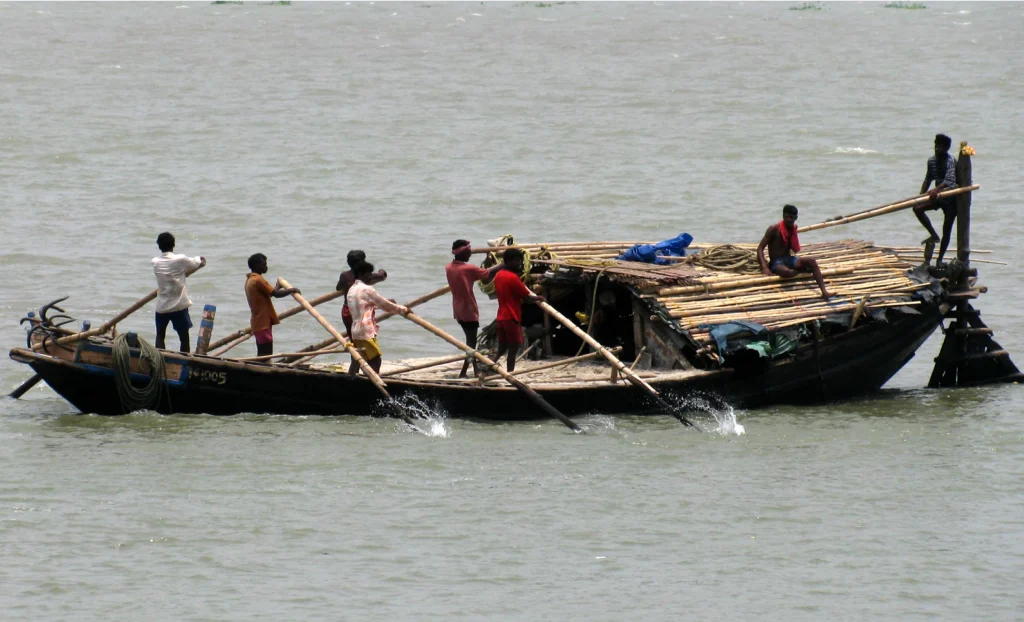
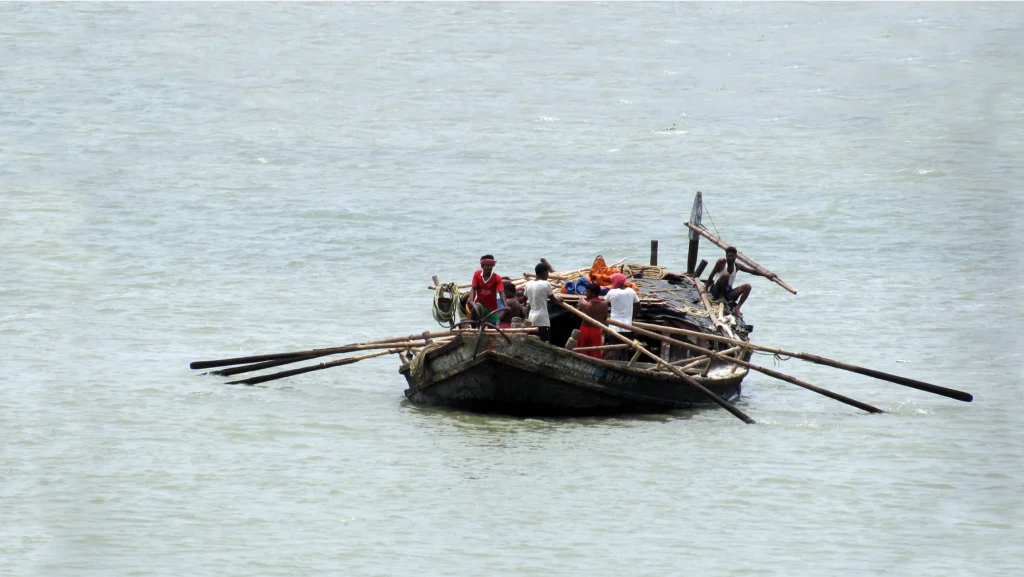
Mahajoni Boats
Boats which are used to carry various goods from the wholesale market of Kolkata (Posta) are called Mahajoni noukas. The carrying capacity of these boats ranges from 800 to 1500 maunds (one maund is equivalent to approximately forty kilograms). Mahajoni boats used to be a lot more popular and played a more important role in the transportation of goods both upriver (to Shaorafuli, Srirampur, Chandannagar) and downriver (to Uluberia, Bauria) from Kolkata.

“Plank paths that has to be followed – The cargo is loaded in the midship portion. Propelling through oars. Note the shape of the boat.”
“While sailing not against the current ; Jal paal: water sail – A rectangular structure kept afloat on ahead of the boat. This unique mechanism gives extra acceleration to a boat floating along the current.”
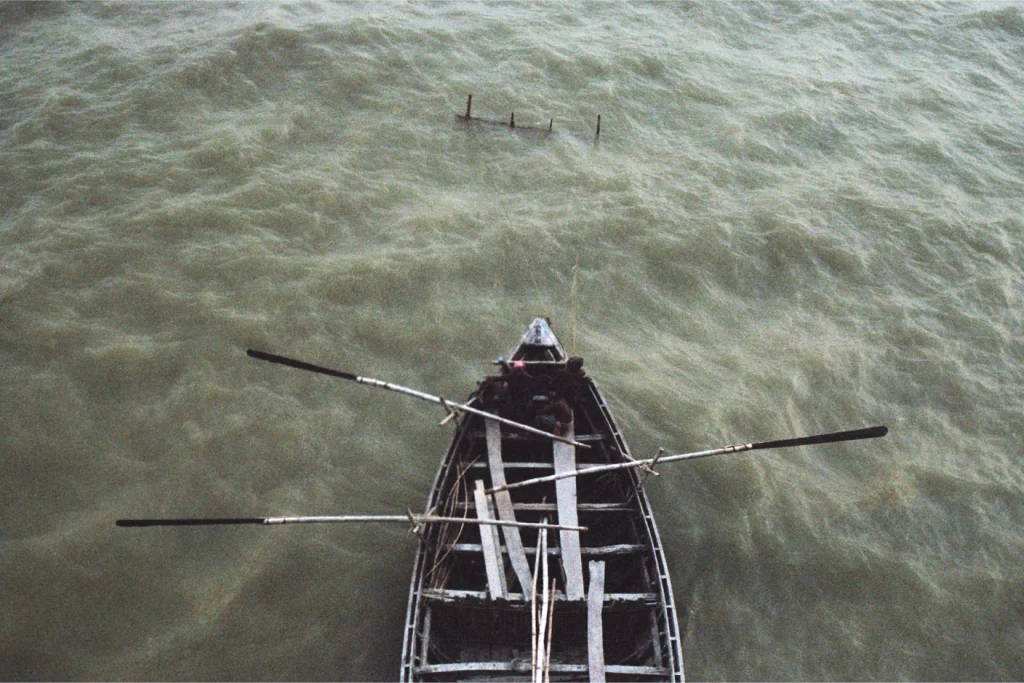
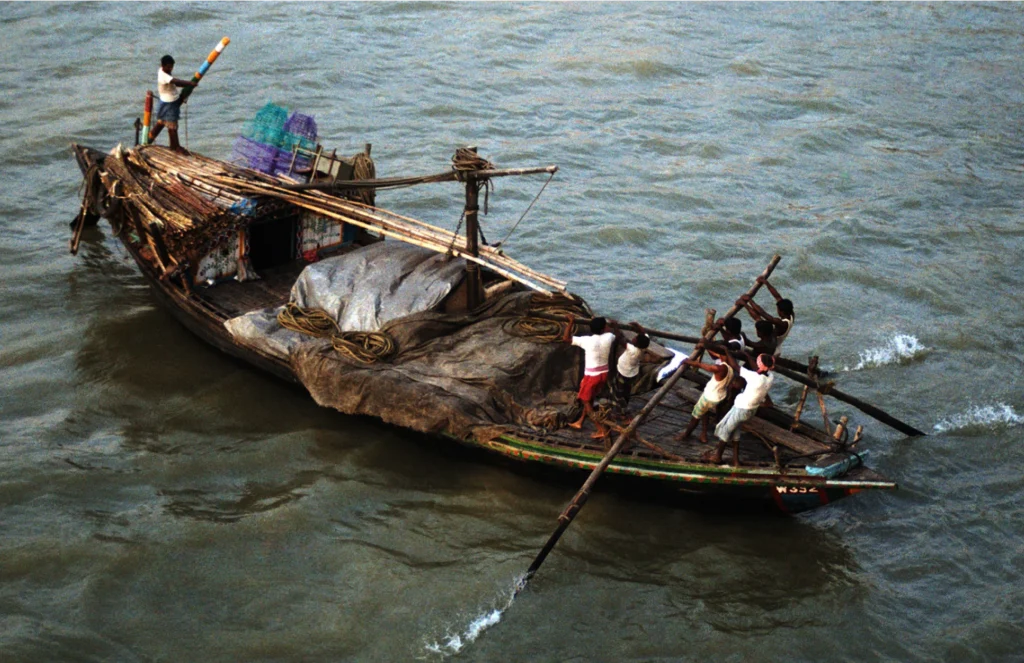
Jele Dingi Boats
Dingi (an Austric term) is an all-purpose boat. A special typological variety of dingi used by the fisherfolk is called jele dingi. The width of this dingi varies according to the amount of cargo it carries. When used as a fishing vessel, the shape becomes long and narrow. These are also shell built, spoon shaped, rabbeted, and stapled boats. Generally, a small shed made of bamboo cane is used as a resting place on the boat. Jele dingis of Kolkata are traditionally 10 to 16 haat (one haat equals 18 inches) in length.
The Jele dingis of Jagannath Ghat have diminished in number though a few of them are used for fishing. Buddha da (da meaning brother), a fisherman, is no longer interested in fishing. He has left his principal occupation and now works as a vendor selling fish in the local market.
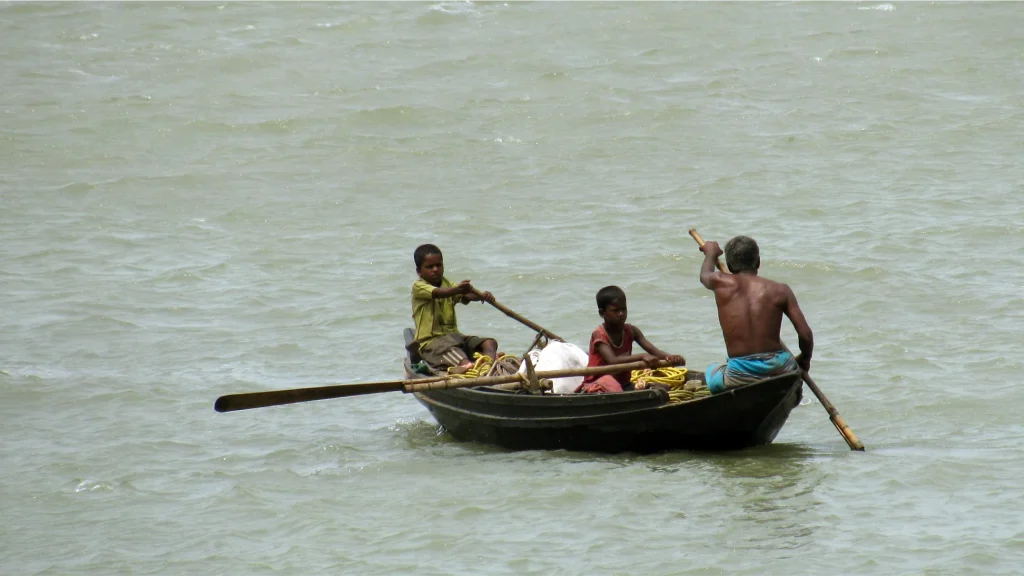
Fishing
Boat Life
Mooring Site
Trump Card
Jele Bachhari Boats
A shell built stapled and rabbeted fishing boat used in the lower Gangetic delta, the Jele Bachharis have an elongated shape. The boat is equipped with fishing nets and other gear and is between 28 to 32 haat in length. These boats are also used in Kolkata for fishing, but the fisherfolk who use them often hail from Baduria of the North Twenty Four Parganas region.
Hulo, a fisherman in Bagbazar, still goes fishing with his 30 haat jele bachhari but rarely catches the exotic Hilsa fish (most popular in West Bengal). Despite his dire financial straits, he continues to hope for a better future, though the underlying doubts remain. While the son of a boatman, Bhola, is not interested in his family’s fishing business, he is rather busy searching for other jobs.
Khorokisti Boats
Khorokisti, a skeleton built straw carrier of Lower Bengal is usually 50 haat (1 haat=1.5 feet) in length and 15 haat in width. Khorokistis frequently ran between Geonkhali of the Medinipur district to the Sundarbans to load 350 to 400 kahon (a unit to measure the amount of straw) of straw which they unloaded in different parts of Kolkata. This boat is propelled by the lug sail (a four-cornered quadrilateral fore and aft sail. This evolved from the square sail and its shape is between the lateen sail and the square sail when it moves without cargo. As fully loaded khorokistis could not move independently with sails, a small boat called chhot was used to tow it along. Chhots were later replaced by motorized boats. Unfortunately, West Bengal has lost almost all its khorokistis.
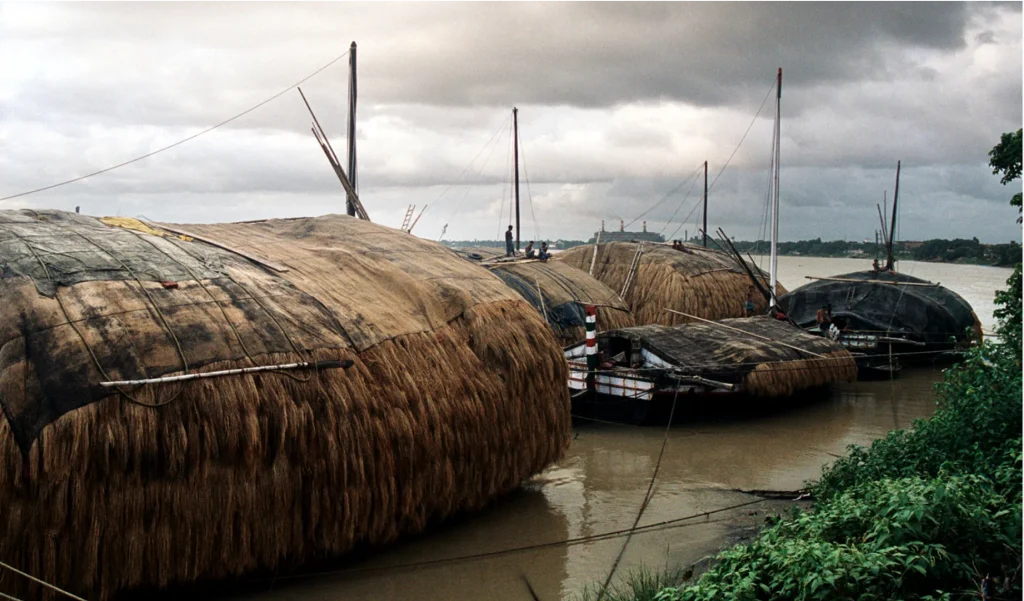
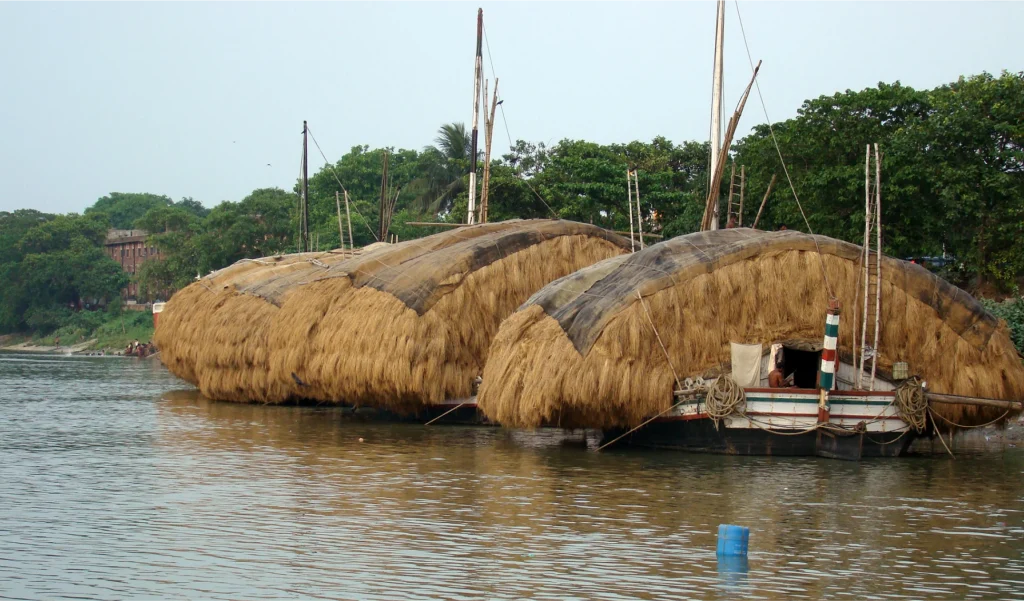
Sultani Boats
Sultani is a cargo boat of the lower Gangetic delta with a carrying capacity ranging from 1500 to 3000 maunds. Sultanis continue to be built but their capacity has increased. It is now motorized, so the mast and sails are no longer in use. Sultanis used to cater cargo to Kolkata from the Sundarbans.

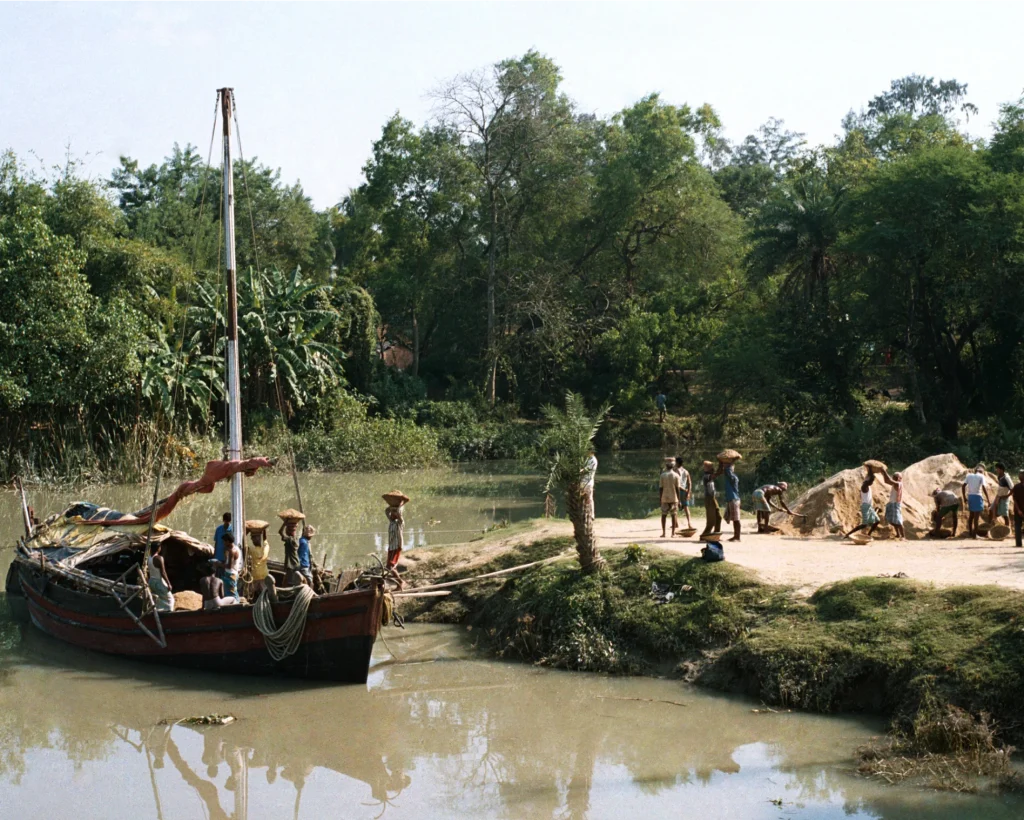
The Future of Boats on the Hooghly
Kolkata earned her laurels because of the Hooghly River and the state of West Bengal earned its wealth or developed on account of its water channels. Cargo and commodities from the eastern parts of India were stacked in warehouses across Kolkata and along the course of the Ganga on boats. The East India Company saw this to their advantage and exported local goods to Europe and the Americas, while keeping the gross profit for themselves.
The once busy riverways have dwindled to mere water channels that no longer carry cargo or pleasure boats. There are a small number of Mahajoni noukas carrying goods between Posta (Barabazar, Kolkata) and Uluberies (Howrah) but this effective, economic, and eco-friendly transportation system is on the verge of collapse.
The Bhanr boat, steered by Sudeb majhi (helmsman), is no longer in use. The owner of this boat is Shyam Babu and the boat has been sitting idle for decades. The irony is, when Shyam Babu’s next generation i.e. his daughter decides to reuse the lohasaal (a kind of exceptionally good wood) of the bhanr boat in making furniture. This has become the fate of Kolkata’s only bhanr boat. Though pansi boats are still in use carrying and lifting sands from the riverbed instead of salt for which they were veteran. Thus, the character of work has changed for pansi. Sultani of Nurpur (South 24 Parganas) has stopped her visit to Kolkata.
When asked if the traditional boat will go extinct soon, Nimai Barick, a 70-year-old boat maker says, “as long as water is there, there will be boats.” A holistic approach is inevitable to maintain the water resources we have or else we are doomed to lose the enriched riverine culture of the Ganga.

